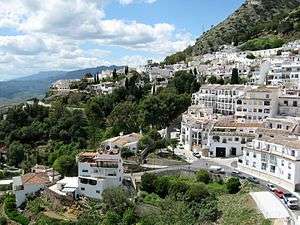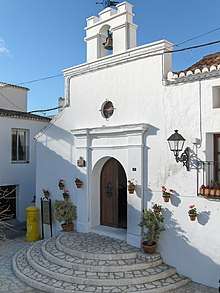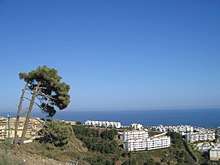Mijas
Mijas is a town and municipality in the Costa del Sol in southern Spain. It consists of Mijas Pueblo a typically Andalusian white-washed village located at a mountain side 428 m above mean sea level.
Understand

Everything outside Mijas Pueblo is called Mijas Costa, the main villages: The more industrial area Las Lagunas that's the most populated part of Mijas and it is totally integrated with Fuengirola. La Cala de Mijas is the main beach resort. Other smaller beach resorts are Riviera del Sol and Calahonda. According to the INE census of 2017, Mijas has 77,151 inhabitants, which makes it the fourth largest municipality of the province. This is concentrated in three main urban centers: Mijas Pueblo, on the hillside of the Sierra de Mijas, the historic center of the municipality; Las Lagunas, in the area called Mijas Costa, is part of the urban continuum of the city of Fuengirola; and the cove, a coastal town. The surface of the municipal term is of 148 km ² and it extends from the coastal saws of the Penibética to the Mediterranean Sea.
Its history dates back to antiquity, with Phoenician and Roman remains, however, in modernity Mijas was a small town dedicated mainly to agriculture and fishing until the explosion of the tourist boom in the 1950s. Since then, the activity tourist and the construction sector have been the engines of the local economy, shooting at the same time population and per capita income. At present it is a multicultural municipality with a percentage of residents of foreign origin and one of the main centers of residential tourism in Andalusia.
Get in
From the main bus station in Fuengirola there are various ways you can get to Mijas and Mijas Costa. Mijas is served by a regular bus service (bus number 122 which terminates in Mijas village itself or number 221 which continues on to Coín) from the main bus station in Fuengirola. The cost of the journey is €1.30. To travel to Mijas Costa or La Cala De Mijas catch the Marbella bus No 220 which stops in La Cala De Mijas, and various other parts of Mijas Costa, Calahonda, Riviera Del Sol and Miraflores. Again the cost of the journey is approx €1.50.
Get around
See
- 🌍 Mijas Pueblo. Spectacular views of the African coastline, the Atlas mountains, Gibraltar and a good part of the Costa del Sol. There is also the Mijas traditional bull ring and the famous plaza in the center of the town where little donkey/horse trolleys can take you on a small trip around the village.
- Hermitage of Our Lady of the Remedies: Raised at the beginning of the 18th century, the reduced church presents a single ship with armor of parhilera, that becomes the greater chapel in vault of edge. Very restored, it keeps the sculpture of dress of the Virgen de los Remedios of the 18th century.
- Hermitage of the Virgin of the Rock: it is a cave hermitage excavated in the rock by a Carmelite brother between 1656 and 1682, to which a sacristy of irregular stone has been added, trying to simulate a natural work. The exterior of the feet made with the same intention, has access of half a point and small bulrush. In an irregular niche carved in the front is the Virgen de la Peña, patron saint of Mijas.
- Church of San Sebastian: its construction corresponds to the late seventeenth century, renovated on numerous occasions. It appears with a nave covered with a truss armor, a square main chapel with a hemispherical vault, and an arched vault with wall paintings of angels.
- Parochial Church of the Immaculate Conception The Parochial Church of the Immaculate Conception was consecrated in 1631, it is in the upper area of the town and on the ruins of the old mosque from which its Mudejar tower was used to fulfill the functions of a belfry.
- Hermitage of CalvaryThe Hermitage of Calvary is located at the foot of the Sierra de Mijas, was built around 1710 for the removal of the Carmelite monks who lived in the hospice and the Monastery of Compás.
- Hermitage of San Antón The Hermitage of Calvary of a single ship, was built in the eighteenth century. The size of the Saint is made of polychrome wood from the same period. It opens to the public on January 17, patron saint of San Antón.
- The Gardens of the Wall in Mijas is about gardens built on the remains of the old fortress that surrounded the town.
- Mirajas Towers of Mijas are four towers beacons that were part of an old coastal defensive line located along the Andalusian Mediterranean coast. From east to west: Torre de Calaburras, Torre Nueva of La Cala del Moral, Battery Tower of La Cala del Moral and Torre de Calahonda.

- The Max Carrousel of Mijas: Miniatures Museum collects a collection of miniature items that includes a "Head of a white man reduced by the gíbaros", the portrait of "Abraham Lincoln" made in painting on the head of a pin, the "Our Father" written on the chant of a business card, the representation of "The Seven Wonders of the World" carved on a toothpick and the "Last Supper of Leonardo Da Vinci" on a bead of rice, among other things.
- The Historical Museum of Mijas: The Historical-Ethnological Museum was inaugurated in 1995 and contains a collection of farming tools, fishing, oil mills, a winery, typical Mijeña cuisine, etc. In addition, itinerant art collections and local crafts are also exhibited.
- Torres Vigía Interpretation Center: The Torres Vigía Interpretation Center is located in the New Tower of La Cala del Moral and contains a sample of the origin of the surveillance of the coastline, the resources used, reproductions at the scale of the 4 Mijas towers and historical texts.
Beaches
- Beaches - the 12-km coastline offers nine beaches, with those in La Cala the Mijas having the blue European quality flag. Mijas is up in the sierra mountains but the beach can be accessed by driving down to town of Fuengirola which is right at the coastline. The trip down is around 15 km.
- Cala de Mijas: The Cala de Mijas is an urban beach with dark, medium-grained sand and some rocky areas and a high degree of occupation. It measures 1.6 km in length and it waves the blue flag.
- Cabo Rocoso beach in Mijas: Cabo Rocoso beach in Mijas is a beach of dark sand of medium grain and moderate waves. It is a semiurban beach with a low occupation degree and about 100 m in length. You can practice windsurfing, sailing and diving.
- Calahonda Beach: One of the best beaches on the Costa del Sol, Calahonda beach, you can practice diving and fishing for its crystal clear waters. On the beach of Calahonda. We will find a golden sand of medium grain and calm waters. It is a semi-urban beach with a high occupation gradient and about 4.5 km in length.
- Playa del Bombo emi-urban beach with dark sand located next to a cliff, making it ideal for scuba diving. It is 1.1 km long and a high degree of occupation.
- Playa del Chaparral Chaparral Beach is a semi-urban beach with rocks and moderate waves. It has an average occupation degree and 4.4 km in length. Possibility of windsurfing, sailing and diving.
- Playa del Faro: Rocky enclave with multiple coves of fine sand. Fishing underwater and with cane is practiced. It is 1.4 km long and has a low occupancy level.
Do
- Rock climbing/Bouldering Parque Miralla, Mijas pueblo
- Plaza de Toros/Bullring Mijas pueblo
- Ethnological Museum of Mijas Mijas pueblo
- Golf - Mijas has 7 Golf courses and more are under construction.
- Mijas Aqua Park in Las Lagunas.
- Rent pedal boats, jet skis, parascending on the beach.
- Visit the Roman ruins at the Torreblanca end of Los Boliches
- Benalmádena port and the aquarium (about 10 km away).
- Train ride to Málaga.
- Ferry cruise to Benalmádena .
- Feria week in mid-October every year. A mixture of music, flamenco, religion, horses, eating and drinking See the Spanish at play, when they party they do it seriously.
- Play golf at one of the many courses within easy reach.No absolutely no to any 26 handicapers, bandits
- Mijas Burrotaxis: If you go to Mijas you can not miss the Burrotaxis. Burrotaxis is a peculiar transport method of Mijas, which appeared at the end of the 1950s, as a result of the fact that some workers from the quarries who returned to their homes on donkeys, were required by tourists to take photographs or take a walk.
- Biennial of the Villa de Mijas art that is celebrated between October and November the first and in June the second.
- Villa de Mijas theater festival, which is held in June the second.
- Flamenco Festival, In August
- Latin Night in August
- Calapop Festival in August
- Celtic Night, In August bands of bagpipes from Gibraltar and northern Spain play.
- Mijas Jazz Festival, in autumn.
- Other cultural events are the Fair of Tales, the Literary Contest of Love Letters, the Market of the Senses and the International Day of the Peoples.
- Beach Activities On the beaches you can practice water sports, rent water bikes, pedal boats, etc.
Buy
- Mijas Town - Mijas has many little independent traditional shops which sell mainly artisian decoration and decort such as hand made pottery, paintings, lots of souvenirs from Spain, and clothing. The shops have there displays outside on the white streets which makes Mijas also so very touristic and attractive.
Eat
There are lots of Spanish tapa bars in the area. You may need to look in the small corridors and streets for traditional good Mediterranean food.
- Mirlo Blanco Restarante
- Los Arcos
Drink

Cruzcampo which is the traditional Spanish beer is served everywhere as is various Spanish wines. Again, lots of places to drink and eat.
Mijas is not really a place for a mad drunken sleazy night out (the nearby town of Fuengirola is better for that), however there are many smaller bars and cafes where one can have a civilised drink. The Boveda del Flamenco bar is a fantastic little place, which used to be the old village jail. It is excellent to sit outside in the summer and watch the world going by. Although many local Spanish residents have their own ways of hanging out in Mijas, discothèques and others are not in the area except nearby cities. If you fancy something to eat or have a nice meal, there are many restaurants about.
Sleep
There are many other places where you can sleep or look for accommodation since everything is very nearby.
- Hotel Mijas. Provides superb accommodation.
- Hotel Tamisa Golf If you are looking for golfing accommodations in the area of Mijas, there is the Mijas golf course.
- Casa Caleta. Excellent family-run B&B in a Finca with fantastic views.
- Apartamentos Torrenueva Park, Urb. Torrenueva Park Ctra. de Cádiz, Km 200, ☎ +34 952 49 40 77.
- Mijas costa Oasis Hotel, Calle Opalo, s/n, ☎ +34 952 93 19 80.
- Hotel IPV Beatriz (Hotel IPV Palace & Spa), Ctra. A7. Km. 207, ☎ +34 902 10 10 12, e-mail: reservas@hotelesipv.com.
- Hotel Las piramides, C/ Miguel Marquez, 43, ☎ +34 952 470 600, e-mail: reservas@hotellaspiramides.com.
- Apartments Ronda4, Paseo Marítimo Rey de España, 96 CP 29640 Los Boliches, Fuengirola, Malaga, España., ☎ +34 952660716, e-mail: info@apartamentosronda4.com.
- Apartamentos Nuriasol, Avd. Francisco Rivera "Paquirri" 23-25, ☎ +34 952663864, e-mail: reservas@apartamentosnuriasol.es.
- There are many options to rental self-catering villas in the area. You can check the following option .